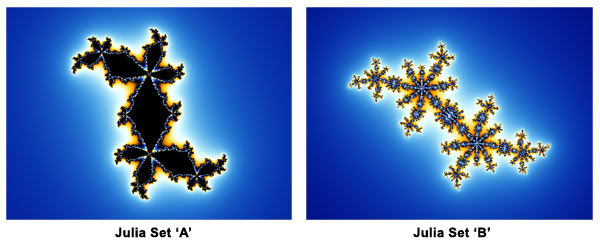Mandelbrot Magic
There are many amazing discoveries about the Mandelbrot Set in store. In this chapter, we will explore the fantastic family of the Julia Sets,
the perfectly self-similar jewels that are intimately related to the Mandelbrot Set. We'll learn how Julia Sets can be connected or disconnected, how these relate to the Mandelbrot Set,
and how the Julia Sets can be seen as "Basins of Attraction". Then we'll discover "Virtual Julia Sets" embedded in the Mandelbrot Set.
We'll also see what happens when we start playing around with the equations that generate these fractals. We'll change the exponents, we'll perturb the starting value of Z as well as C,
and finally we'll see some entirely distinct equations that nonetheless generate the Mandelbrot Set, in the phenomenon known as Universality. Julia SetsClick in the Mandelbrot Set in the left panel to see the associated Julia Set in the right panel. Use the arrow keys to nudge the cursor by one pixel at a time. <Alt>-click inside either window to zoom in, <Ctrl>-click to zoom out.
Every point C in the plane of the Mandelbrot Set (above left) has an associated Julia Set (right panel).
Click in the black area in the Mandelbrot Set in the left panel above. Explore the shapes of the Julia Sets in the right panel that correspond to
various parts of the Mandlebrot Set.
The Fundamental Distinction - the two kinds of Julia SetsNotice that when you click a point inside the Mandelbrot Set, the Julia Sets are black shapes with a self-similar 'coastline' edge, whereas when you click somewhere outside the Mandelbrot Set, the corresponding Julia Sets are fragmented into many self-similar islands.This is one of the ways to define the Mandelbrot Set: It is the set of all values of C that generate connected Julia Sets. Every Julia Set is exactly self-similar across scales, while the Mandelbrot can gain in complexity as you venture deeper.

The Mandelbrot - Julia Similarity
Explore deeper in the Mandelbrot Set by <Alt>-clicking in the left panel somewhere near the edge of the Mandelbrot Set. After zooming in, explore the different Julia Sets from just
inside and outside the border of the Mandelbrot Set. Observe the equisite sensitivity near the border: A point C just inside the Mandelbrot Set
creates a connected Julia Set, while a point just outside the Set creates disconnected Julia Sets.
As you zoom deeper into the edge of the Mandelbrot Set, watch the behavior of the Julia Set. Wherever you zoom into the edge of the Mandelbrot Set,
the Julia Set begins to take on the same appearance as the local area of the Mandelbrot Set. As you go deeper, the Mandelbrot Set and the Julia Set from the corresponding location begin to resemble each other more and more closely.
The only places where this is not true are the tiny replicas of the Mandelbrot Set which never appear in the Julia Sets.
Observe the relationship between the orbit diagram and the Julia Set. Wherever there's a black island-like Julia Set, the orbits are closed, that is, they stay finite.
Wherever the Julia Sets are colorful - and disconnected - the orbits fly away to infinity.
Basins of Attraction
You may be wondering: What exactly are the Julia Sets? They are based on the identical equation as the Mandlebrot Set: Zn+1 = Zn2 + C
However, instead of looking at the fates of all the starting values of C, as we do in the Mandelbrot Set, we choose ONE value for C, and ask what happens
for different values of Z. (Remember, in the Mandelbrot Set, we start with Z = 0. but in the Julia Sets, we're testing the fate of all
starting values of Z, for a given value of C.)
For the connected Julia Sets (where C is inside the Mandelbrot Set), all the starting values of Z in the black, connected area will stay finite,
whereas the starting values of Z from outside the black area will go to infinity.
We call a black, connected Julia Set a "Basin of Attraction", because any value of Z inside the black area is attracted into a stable, finite orbit. All other starting values of Z are repelled, and orbit away to infinity.
In the next section, we'll observe the strange phenomenon of "Virtual Julia Sets" embedded in the Mandelbrot Set.
|
|
<- PREVIOUS NEXT -> © Fractal Foundation. |